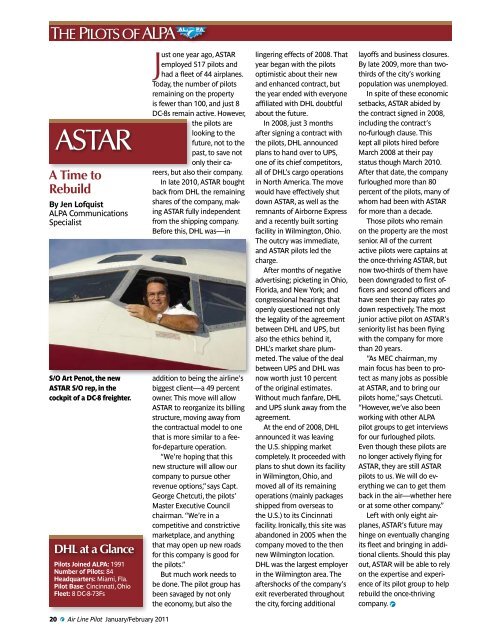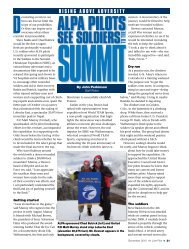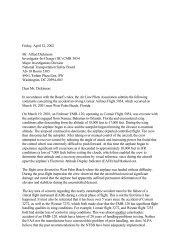The Pilots of ALPA - Air Line Pilots Association
The Pilots of ALPA - Air Line Pilots Association
The Pilots of ALPA - Air Line Pilots Association
You also want an ePaper? Increase the reach of your titles
YUMPU automatically turns print PDFs into web optimized ePapers that Google loves.
THE PILOTS OF <strong>ALPA</strong><br />
ASTAR<br />
A Time to<br />
Rebuild<br />
By Jen L<strong>of</strong>quist<br />
<strong>ALPA</strong> Communications<br />
Specialist<br />
S/O Art Penot, the new<br />
ASTAR S/O rep, in the<br />
cockpit <strong>of</strong> a DC-8 freighter.<br />
DHL at a Glance<br />
<strong>Pilots</strong> Joined <strong>ALPA</strong>: 1991<br />
Number <strong>of</strong> <strong>Pilots</strong>: 84<br />
Headquarters: Miami, Fla.<br />
Pilot Base: Cincinnati, Ohio<br />
Fleet: 8 DC-8-73Fs<br />
20 <strong>Air</strong> <strong>Line</strong> Pilot January/February 2011<br />
Just one year ago, ASTAR<br />
employed 517 pilots and<br />
had a fleet <strong>of</strong> 44 airplanes.<br />
Today, the number <strong>of</strong> pilots<br />
remaining on the property<br />
is fewer than 100, and just 8<br />
DC-8s remain active. However,<br />
the pilots are<br />
looking to the<br />
future, not to the<br />
past, to save not<br />
only their careers,<br />
but also their company.<br />
In late 2010, ASTAR bought<br />
back from DHL the remaining<br />
shares <strong>of</strong> the company, making<br />
ASTAR fully independent<br />
from the shipping company.<br />
Before this, DHL was—in<br />
addition to being the airline’s<br />
biggest client—a 49 percent<br />
owner. This move will allow<br />
ASTAR to reorganize its billing<br />
structure, moving away from<br />
the contractual model to one<br />
that is more similar to a feefor-departure<br />
operation.<br />
“We’re hoping that this<br />
new structure will allow our<br />
company to pursue other<br />
revenue options,” says Capt.<br />
George Chetcuti, the pilots’<br />
Master Executive Council<br />
chairman. “We’re in a<br />
competitive and constrictive<br />
marketplace, and anything<br />
that may open up new roads<br />
for this company is good for<br />
the pilots.”<br />
But much work needs to<br />
be done. <strong>The</strong> pilot group has<br />
been savaged by not only<br />
the economy, but also the<br />
lingering effects <strong>of</strong> 2008. That<br />
year began with the pilots<br />
optimistic about their new<br />
and enhanced contract, but<br />
the year ended with everyone<br />
affiliated with DHL doubtful<br />
about the future.<br />
In 2008, just 3 months<br />
after signing a contract with<br />
the pilots, DHL announced<br />
plans to hand over to UPS,<br />
one <strong>of</strong> its chief competitors,<br />
all <strong>of</strong> DHL’s cargo operations<br />
in North America. <strong>The</strong> move<br />
would have effectively shut<br />
down ASTAR, as well as the<br />
remnants <strong>of</strong> <strong>Air</strong>borne Express<br />
and a recently built sorting<br />
facility in Wilmington, Ohio.<br />
<strong>The</strong> outcry was immediate,<br />
and ASTAR pilots led the<br />
charge.<br />
After months <strong>of</strong> negative<br />
advertising; picketing in Ohio,<br />
Florida, and New York; and<br />
congressional hearings that<br />
openly questioned not only<br />
the legality <strong>of</strong> the agreement<br />
between DHL and UPS, but<br />
also the ethics behind it,<br />
DHL’s market share plummeted.<br />
<strong>The</strong> value <strong>of</strong> the deal<br />
between UPS and DHL was<br />
now worth just 10 percent<br />
<strong>of</strong> the original estimates.<br />
Without much fanfare, DHL<br />
and UPS slunk away from the<br />
agreement.<br />
At the end <strong>of</strong> 2008, DHL<br />
announced it was leaving<br />
the U.S. shipping market<br />
completely. It proceeded with<br />
plans to shut down its facility<br />
in Wilmington, Ohio, and<br />
moved all <strong>of</strong> its remaining<br />
operations (mainly packages<br />
shipped from overseas to<br />
the U.S.) to its Cincinnati<br />
facility. Ironically, this site was<br />
abandoned in 2005 when the<br />
company moved to the then<br />
new Wilmington location.<br />
DHL was the largest employer<br />
in the Wilmington area. <strong>The</strong><br />
aftershocks <strong>of</strong> the company’s<br />
exit reverberated throughout<br />
the city, forcing additional<br />
lay<strong>of</strong>fs and business closures.<br />
By late 2009, more than twothirds<br />
<strong>of</strong> the city’s working<br />
population was unemployed.<br />
In spite <strong>of</strong> these economic<br />
setbacks, ASTAR abided by<br />
the contract signed in 2008,<br />
including the contract’s<br />
no-furlough clause. This<br />
kept all pilots hired before<br />
March 2008 at their pay<br />
status though March 2010.<br />
After that date, the company<br />
furloughed more than 80<br />
percent <strong>of</strong> the pilots, many <strong>of</strong><br />
whom had been with ASTAR<br />
for more than a decade.<br />
Those pilots who remain<br />
on the property are the most<br />
senior. All <strong>of</strong> the current<br />
active pilots were captains at<br />
the once-thriving ASTAR, but<br />
now two-thirds <strong>of</strong> them have<br />
been downgraded to first <strong>of</strong>ficers<br />
and second <strong>of</strong>ficers and<br />
have seen their pay rates go<br />
down respectively. <strong>The</strong> most<br />
junior active pilot on ASTAR’s<br />
seniority list has been flying<br />
with the company for more<br />
than 20 years.<br />
“As MEC chairman, my<br />
main focus has been to protect<br />
as many jobs as possible<br />
at ASTAR, and to bring our<br />
pilots home,” says Chetcuti.<br />
“However, we’ve also been<br />
working with other <strong>ALPA</strong><br />
pilot groups to get interviews<br />
for our furloughed pilots.<br />
Even though these pilots are<br />
no longer actively flying for<br />
ASTAR, they are still ASTAR<br />
pilots to us. We will do everything<br />
we can to get them<br />
back in the air—whether here<br />
or at some other company.”<br />
Left with only eight airplanes,<br />
ASTAR’s future may<br />
hinge on eventually changing<br />
its fleet and bringing in additional<br />
clients. Should this play<br />
out, ASTAR will be able to rely<br />
on the expertise and experience<br />
<strong>of</strong> its pilot group to help<br />
rebuild the once-thriving<br />
company.





